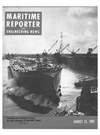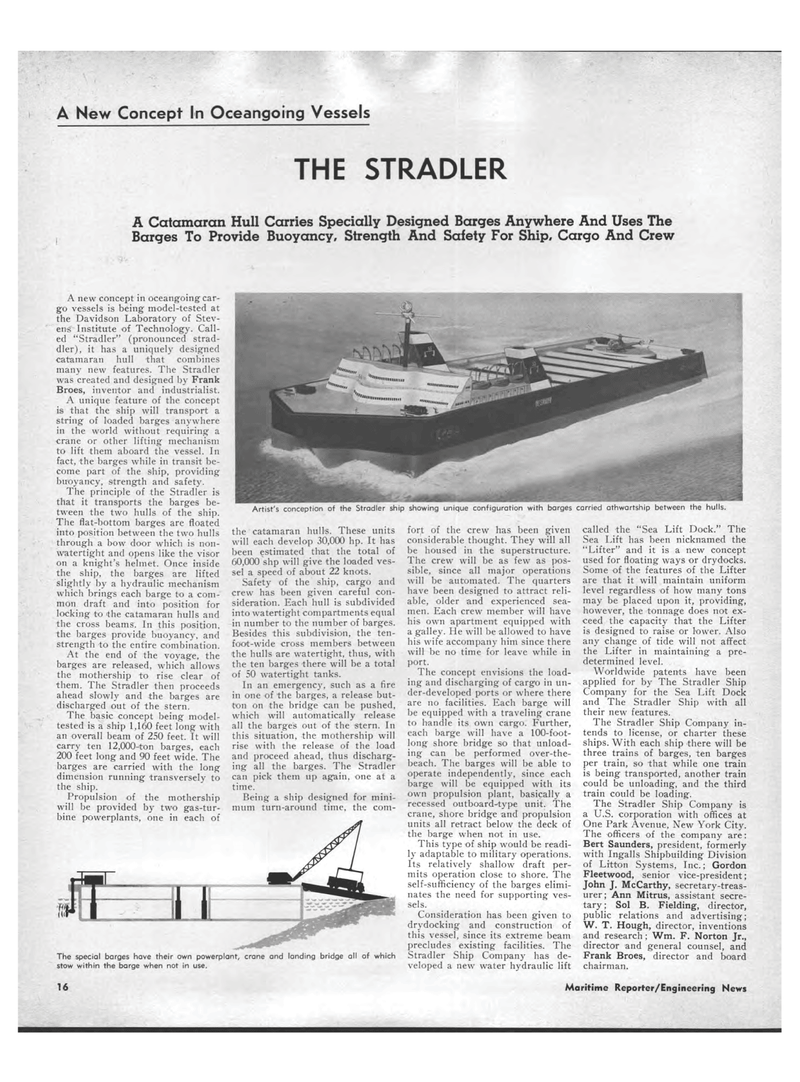
Page 14: of Maritime Reporter Magazine (August 15, 1969)
Read this page in Pdf, Flash or Html5 edition of August 15, 1969 Maritime Reporter Magazine
A New Concept In Oceangoing Vessels THE STRADLER A Catamaran Hull Carries Specially Designed Barges Anywhere And Uses The Barges To Provide Buoyancy, Strength And Safety For Ship, Cargo And Crew A new concept in oceangoing car-go vessels is being model-tested at the Davidson Laboratory of Stev-ens Institute of Technology. Call-ed "Stradler" (pronounced strad-dler), it has a uniquely designed catamaran hull that combines many new features. The Stradler was created and designed by Frank Broes, inventor and industrialist. A unique feature of the concept is that the ship will transport a string of loaded barges anywhere in the world without requiring a crane or other lifting mechanism to lift them aboard the vessel. In fact, the barges while in transit be-come part of the ship, providing buoyancy, strength and safety. The principle of the Stradler is that it transports the barges be-tween the two hulls of the ship. The flat-bottom barges are floated into position between the two hulls through a bow door which is non-watertight and opens like the visor on a knight's helmet. Once inside the ship, the barges are lifted slightly by a hydraulic mechanism which brings each barge to a com-mon draft and into position for locking to the catamaran hulls and the cross beams. In this position, the barges providf buoyancy, and strength to the entire combination. At the end of the voyage, the barges are released, which allows the mothership to rise clear of them. The Stradler then proceeds ahead slowly and the barges are discharged out of the stern. The basic concept being model-tested is a ship 1,160 feet long with an overall beam of 250 feet. It will carry ten 12,000-ton barges, each 200 feet long and 90 feet wide. The barges are carried with the long dimension running transversely to the ship. Propulsion of the mothership will be provided by two gas-tur-bine powerplants, one in each of Artist's conception of the Stradler ship showing unique configuration with barges carried athwartship between the hulls. the catamaran hulls. These units will each develop 30,000 hp. It has been estimated that the total of 60,000 shp will give the loaded ves-sel a speed of about 22 knots. Safety of the ship, cargo and crew has been given careful con-sideration. Each hull is subdivided into watertight compartments equal in number to the number of barges. Besides this subdivision, the ten-foot-wide cross members between the hulls are watertight, thus, with the ten barges there will be a total of 50 watertight tanks. In an emergency, such as a fire in one of the barges, a release but-ton on the bridge can be pushed, which will automatically release all the barges out of the stern. In this situation, the mothership will rise with the release of the load and proceed ahead, thus discharg-ing all the barges. The Stradler can pick them up again, one at a time. Being a ship designed for mini-mum turn-around time, the com-The special barges have their own powerplant, crane and landing bridge all of which stow within the barge when not in use. fort of the crew has been given considerable thought. They will all be housed in the superstructure. The crew will be as few as pos-sible, since all major operations will be automated. The quarters have been designed to attract reli-able, older and experienced sea-men. Each crew member will have his own apartment equipped with a galley. He will be allowed to have his wife accompany him since there will be no time for leave while in port. The concept envisions the load-ing and discharging of cargo in un-der-developed ports or where there are no facilities. Each barge will be equipped with a traveling crane to handle its own cargo. Further, each barge will have a 100-foot-long shore bridge so that unload-ing can be performed over-the-beach. The barges will be able to operate independently, since each barge will be equipped with its own propulsion plant, basically a recessed outboard-type unit. The crane, shore bridge and propulsion units all retract below the deck of the barge when not in use. This type of ship would be readi-ly adaptable to military operations. Its relatively shallow draft per-mits operation close to shore. The self-sufficiency of the barges elimi-nates the need for supporting ves-sels. Consideration has been given to drydocking and construction of this vessel, since its extreme beam precludes existing facilities. The Stradler Ship Company has de-veloped a new water hydraulic lift called the "Sea Lift Dock." The Sea Lift has been nicknamed the "Lifter" and it is a new concept used for floating ways or drydocks. Some of the features of the Lifter are that it will maintain uniform level regardless of how many tons may be placed upon it, providing, however, the tonnage does not ex-ceed the capacity that the Lifter is designed to raise or lower. Also any change of tide will not affect the Lifter in maintaining a pre-determined level. Worldwide patents have been applied for by The Stradler Ship Company for the Sea Lift Dock and The Stradler Ship with all their new features. The Stradler Ship Company in-tends to license, or charter these ships. With each ship there will be three trains of barges, ten barges per train, so that while one train is being transported, another train could be unloading, and the third train could be loading. The Stradler Ship Company is a U.S. corporation with offices at One Park Avenue, New York City. The officers of the company are: Bert Saunders, president, formerly with Ingalls Shipbuilding Division of Litton Systems, Inc.; Gordon Fleetwood, senior vice-president; John J. McCarthy, secretary-treas-urer; Ann Mitrus, assistant secre-tary; Sol B. Fielding, director, public relations and advertising; W. T. Hough, director, inventions and research; Wm. F. Norton Jr., director and general counsel, and Frank Broes, director and board chairman. 16 Maritime Reporter/Engineering News

 13
13

 15
15
